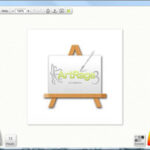Sometimes, the best tools are the simplest. MS Paint is a very basic (read: oft-ignored) application that has evolved over the years not just for sketching and painting rudimentary drawings, but as an image-editing tool as well.
So the question becomes, “In the prevalence of sophisticated programs like Adobe Photoshop gaining widespread use, why bother with such an inferior application?”
One strong argument for using MS Paint is that it is pre-installed on every computer that runs Windows. You need not stumble around an unfamiliar application when on someone else’s system, or spend hundreds on multiple licenses getting your favorite editor on more than one computer. Just open good ol’ Paint and away you go. Also, it is free. With photo editors easily costing in the hundreds of dollars, and professional editions priced higher yet, a free program is always a welcome addition to your bag of tricks.
1) Resize a Picture – Open a picture in Paint. Move the mouse to the toolbar, and click on Image. Select Stretch / Skew. A box will appear labeled “Stretch”. By the “Horizontal” and “Vertical” textboxes you can enter any number form 1 to 500. If you enter “50” for the width, your picture will be 50% narrower. Entering “500” will make it 500% wider, and so on. Just make sure to enter the same percentage for both Horizontal and Vertical adjustments to keep the picture from getting too distorted. This is especially useful for those extremely large photographs that do not fit on the screen, and manually stretching or shrinking it would be more difficult.
2) Crop a Photo – When a large picture has a lot of unnecessary ‘guests’: say you took a picture of your friend on the tour bus, and in the frame she is all the way to the left. The rest of the frame has random people in the background, and you don’t want them in the picture. Open the picture in Paint, and go to Image, and Select Attributes. Under Width there is already a number entered; this is the current width of the image. Enter a smaller number. How small? If you want to reduce the width by half, enter half of the existing number.
Voila! The strangers have vanished, and your friend dominates the photo.
(And if you goof up, there is always the Ctrl-Z command that will undo the most recent thing you did)
3) Flip a Photo – to create a mirror image of the photo, click Image (are you beginning to think this is my favorite feature in Paint? Me, too.) and select Flip/Rotate. Pick the Horizontal option, and click on OK.
4) Crop a Photo (part 2) – this makes use of #2 and #3. If your subject is too far to the right side this time, simply cropping the picture that way will cut her out (sorry!) because it works on the rightmost portion first. The solution:
-Flip the photo horizontally.
-Crop the photo just as in #2.
-Recheck your results; adjust if necessary.
-Flip the photo horizontally again to return it to its original orientation.
-Save your work.
5) Crop a Photo (part 2-b) – not sure about all this flipping? Press Ctrl-A or go to Edit/Select All. This selects the entire picture, surrounding it with dotted lines. Drag the picture as far to the left as you need. Crop the right side as in #2 to get rid of the white space.
6) Compress a Bitmap – sometimes I get sent a normal-sized photo that just takes up way too much storage space, because it was saved in .bmp format. Saving it in another format can reduce it to as little as a tenth of the space it needs. Open the picture in Paint and go to File/Save As… Just below the textbox where you can enter the file name is a pull-down menu labeled “Save as Type“. For better compression, you can pick the .jpg format. Other formats like .tif and .png also work quite well, but .jpg is the most widely-recognized standard.
You can now either delete the original .bmp and keep the .jpg, or if you really want to, save the .bmp to a CD.
(Warning: Do not use the .gif format for photographs. You may be tempted because it can reduce a picture more than a .jpg compression can. It supports very few colors, however, and will not retain enough of the original quality. At best you will have a grainy, blurry impression of the original.)
This is all made possible by relatively recent versions of Paint supporting more file formats, not just .bmp or .gif, thus expanding its usefulness beyond simple drawings. Paint is often overlooked and underrated, but can do several jobs in a pinch. Properly utilized, it can be a nifty tool in your repertoire. Especially if you find yourself away from your own computer, you can always open Paint and do surprisingly a lot with it. Not bad for a free, pre-installed program, eh?





